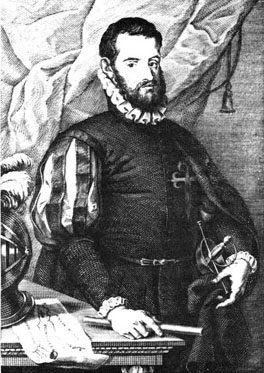| Pedro Menéndez de Avilés  Born: 15-Feb-1519 Born: 15-Feb-1519
Birthplace: Avilés, Spain
Died: 17-Sep-1574
Location of death: Santander, Spain
Cause of death: War
Gender: Male
Religion: Roman Catholic
Race or Ethnicity: White
Sexual orientation: Straight
Occupation: Military Nationality: Spain
Executive summary: Founder of St. Augustine, Florida Spanish seaman, founder of St. Augustine, Florida, was born at AvilÚs in Asturias on the 15th of February 1519. His family were gentry, and he was one of nineteen brothers and sisters. At the age of fourteen he ran away to sea, and was engaged until he was thirty in a life of adventure as a corsair. In 1549 during peace between France and Spain he was commissioned by the emperor Charles V to clear the north coast of Spain and the Canaries of French pirates. In 1554 he was appointed captain-general of the "flota" or convoy which carried the trade between Spain and America. The appointment was made by the emperor over the head and against the will of the Casa de Contratacion, or governing board of the American trade. In this year, and before he sailed to America, AvilÚs accompanied the prince of Spain, afterwards Philip II, to England, where he had gone to marry Queen Mary. As commander of the flota he displayed a diligence, and achieved a degree of success in bringing back treasure, which earned him the hearty approval of the emperor. But his devotion to the imperial service, and his steady refusal to receive bribes as the reward for permitting breaches of the regulations, made him unpopular with the merchants, while his high-handed ways offended the Casa de Contratacion. Reappointed commander in 1557; and knowing the hostility of the Casa, he applied for service elsewhere. The war with France in which Spain and England were allies was then in progress, and until the close of 1559 ample occupation was found for AvilÚs in bringing money and recruits from Spain to Flanders. When peace was restored he commanded the fleet which brought Philip II back from the Low Countries to Spain. In 1560 he was again appointed to command the flota, and he made a most successful voyage to America and back, in that and the following year. His relations with the Casa de Contratacion were, however, as strained as ever. On his return from another voyage in 1563 he was arrested by order of the Casa, and was detained in prison for twenty months. What the charges brought against him were is not known. AvilÚs in a letter to the king avows his innocence, and he was finally discharged by the judges, but not until they had received two peremptory orders from the king to come to a decision.
On his release he prepared to sail to the Bermudas to seek for his son Juan, who had been shipwrecked in the previous year. At that time the French Huguenots were engaged in endeavoring to plant a colony in Florida. As the country had been explored by the Spaniards they claimed it as theirs, and its position on the track of the homeward-bound trade of Mexico rendered its possession by any other power highly dangerous. Philip II endeavored to avert the peril by making an asiento, or contract, with AvilÚs, by which he advanced 15,000 ducats to the seaman, and constituted him proprietor of any colony which he could establish in Florida, on condition that the money was repaid. The contract was signed on the 20th of March 1565. AvilÚs sailed on the 28th of July of the same year with one vessel of 600 tons, ten sloops and 1500 men. On the 28th of August (the Feast of St. Augustine), he entered and named the Bay of St. Augustine, and began a fort there. He took the French post of Fort Caroline on the 20th of September 1565, and in October exterminated a body of Frenchmen who, under the Huguenot Jean Ribault, had arrived on the coast of Florida to relieve their colony. The Spanish commander, after slaying nearly all his prisoners, hung their bodies on trees, with the inscription, "Not as Frenchmen but as Lutherans." A French sea-captain named Dominique de Gourgues revenged the massacre by capturing in 1568 Fort San Mateo (as the Spanish had renamed Fort Caroline), and hanging the garrison, with the inscription, "Not as Spaniards but as murderers." Until 1567 AvilÚs remained in Florida, busy with his colony. In that year he returned to Spain. He made one more voyage to Florida, and died on the 17th of September 1574. AvilÚs married Maria de Solis, when very young, and left three daughters. His letters prove him to have been a pious and high-minded officer, who never imagined that he could be supposed by any honest man to have gone too far in massacring the Frenchmen, whom he regarded as pirates and heretics.
Wife: Maria de Solis
Ran Away From Home age 14
Exhumed 1924
Do you know something we don't?
Submit a correction or make a comment about this profile
Copyright ©2021 Soylent Communications
|